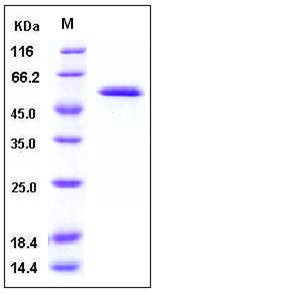Human Glucokinase / GCK Protein
FGQTL3,GK,GLK,HHF3,HK4,HKIV,HXKP,LGLK,MODY2
- 100ug (NPP3894) Please inquiry
| Catalog Number | P11078-HNCE |
|---|---|
| Organism Species | Human |
| Host | E. coli |
| Synonyms | FGQTL3,GK,GLK,HHF3,HK4,HKIV,HXKP,LGLK,MODY2 |
| Molecular Weight | The recombinant human GCK isoform 1 consists of 466 amino acids and predicts a molecular mass of 52.2 kDa as estimated in SDS-PAGE under reducing conditions. |
| predicted N | Gly |
| SDS-PAGE |  |
| Purity | > 95 % as determined by SDS-PAGE |
| Protein Construction | A DNA sequence encoding the human glucokinase isoform 1 (NP_000153.1) (Leu 2-Gln 465) was expressed, fused with two additional amino acids (Gly & Pro) at the N-terminus. |
| Bio-activity | Kinase activity untested |
| Research Area | Signaling |Signal Transduction |Signaling Pathway |Representative pathway |Apoptosis Signaling pathway |Bcl-2 Proteins and Regulators | |
| Formulation | Supplied as sterile 20mM Tris, 10% Glycerol, pH 8.0 1. Normally 5 % - 8 % trehalose, mannitol and 0.01% Tween80 are added as protectants before lyophilization. Specific concentrations are included in the hardcopy of COA. |
| Background | Glucokinase belongs to the bacterial glucokinase family. Hexokinases phosphorylate glucose to produce glucose-6-phosphate, the first step in most glucose metabolism pathways. Alternative splicing of this gene results in three tissue-specific forms of glucokinase, one found in pancreatic islet beta cells and two found in liver. The protein localizes to the outer membrane of mitochondria. In contrast to other forms of hexokinase, this enzyme is not inhibited by its product glucose-6-phosphate but remains active while glucose is abundant. Mutations in this gene have been associated with non-insulin dependent diabetes mellitus (NIDDM), maturity onset diabetes of the young, type 2 (MODY2) and persistent hyperinsulinemic hypoglycemia of infancy (PHHI). It can Catalyzes the initial step in utilization of glucose by the beta-cell and liver at physiological glucose concentration. Glucokinase has a high Km for glucose, and so it is effective only when glucose is abundant. The role of GCK is to provide G6P for the synthesis of glycogen. Pancreatic glucokinase plays an important role in modulating insulin secretion. Hepatic glucokinase helps to facilitate the uptake and conversion of glucose by acting as an insulin-sensitive determinant of hepatic glucose usage. It has a pivotal role as glucose sensor of the pancreatic beta-cells. Glucokinase explains the capacity, hexose specificity, affinities, sigmoidicity, and anomeric preference of pancreatic islet glycolysis, and because stimulation of glucose metabolism is a prerequisite of glucose stimulation of insulin release, glucokinase also explains many characteristics of this beta-cell function. Glucokinase of the beta-cell is induced or activated by glucose in contrast to liver glucokinase, which is regulated by insulin. Tissue-specific regulation corresponds with observations that liver and pancreatic beta-cell glucokinase are structurally distinct. Glucokinase could play a glucose-sensor role in hepatocytes as well, and certain forms of diabetes mellitus might be due to glucokinase deficiencies in pancreatic beta-cells, hepatocytes, or both. |
| Reference |
